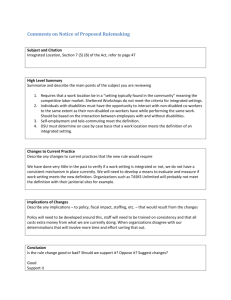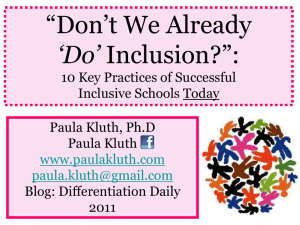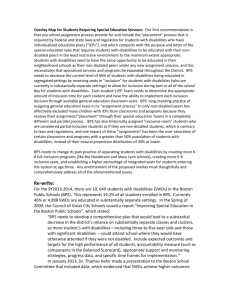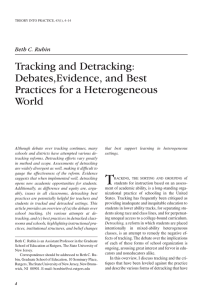20100725-ED451Response4
advertisement
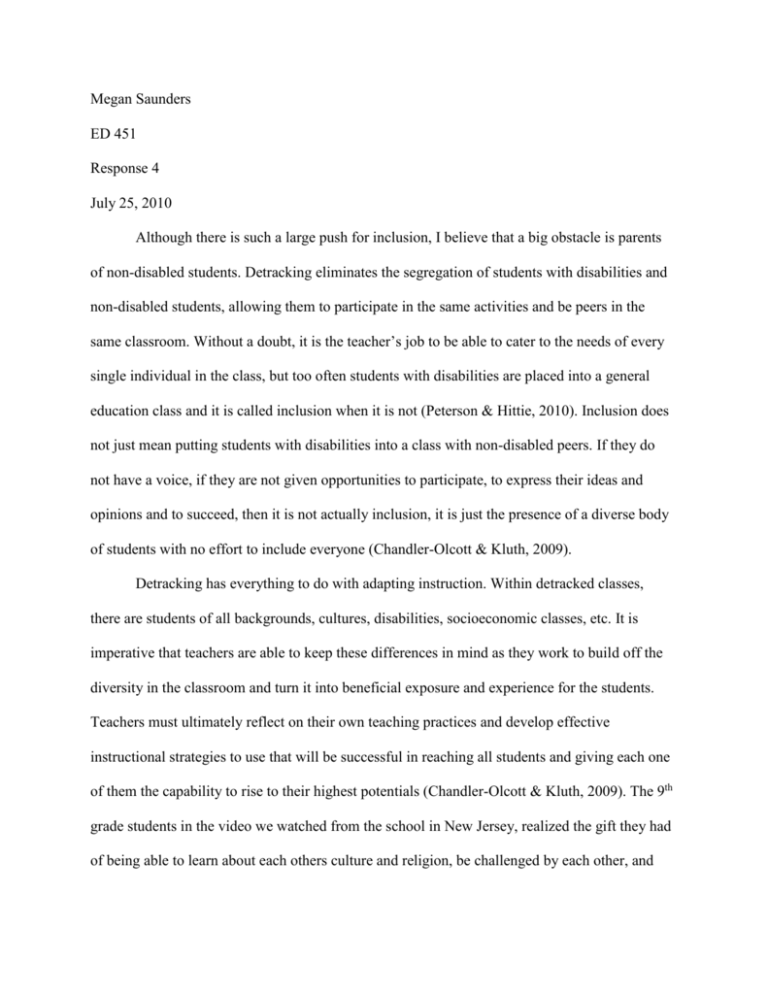
Megan Saunders ED 451 Response 4 July 25, 2010 Although there is such a large push for inclusion, I believe that a big obstacle is parents of non-disabled students. Detracking eliminates the segregation of students with disabilities and non-disabled students, allowing them to participate in the same activities and be peers in the same classroom. Without a doubt, it is the teacher’s job to be able to cater to the needs of every single individual in the class, but too often students with disabilities are placed into a general education class and it is called inclusion when it is not (Peterson & Hittie, 2010). Inclusion does not just mean putting students with disabilities into a class with non-disabled peers. If they do not have a voice, if they are not given opportunities to participate, to express their ideas and opinions and to succeed, then it is not actually inclusion, it is just the presence of a diverse body of students with no effort to include everyone (Chandler-Olcott & Kluth, 2009). Detracking has everything to do with adapting instruction. Within detracked classes, there are students of all backgrounds, cultures, disabilities, socioeconomic classes, etc. It is imperative that teachers are able to keep these differences in mind as they work to build off the diversity in the classroom and turn it into beneficial exposure and experience for the students. Teachers must ultimately reflect on their own teaching practices and develop effective instructional strategies to use that will be successful in reaching all students and giving each one of them the capability to rise to their highest potentials (Chandler-Olcott & Kluth, 2009). The 9th grade students in the video we watched from the school in New Jersey, realized the gift they had of being able to learn about each others culture and religion, be challenged by each other, and help develop deeper critical thinking skills by being in a detracked English class. There are numerous benefits for all students in the classroom when everyone is included and therefore everyone can learn from each other’s ideas and experiences. If students with disabilities are removed from a class and placed in a separate one, then that means that often the solution was not for the teacher to reflect on his or her teaching and come up with innovative ways to present topics and activities to all students, and being confident and creative to meet to the needs of everyone. In one of the readings my base group read, Chandler-Olcott and Kluth (2009) believe that everyone, teachers, non-disabled students and students with disabilities, can benefit from including students with autism in the literacy classroom. Many wealthy, suburban parents do not like inclusion or detracking because they believe it holds their intelligent children back, having to slow instruction to make sure the students with disabilities can learn. Parents do not often realize the extraordinary benefits that their children can have by having students with disabilities, and autism, in their classes. Oppositely, the parents who fight for school reforms in urban schools struggle to be taken seriously since they are often minorities and school administration do not respect their ideas. Martinez-Cosio (2010) is clear about how cultural capital plays into affecting how much influence parents can have on school reform. For example, a group of Latino parents called the Latino coalition was less successful in engaging in school reform because they had a more aggressive approach. The African American Coalition on the other hand was more successful because they worked within the system. Minority families and parents have a difficult time having input into their children’s schools and fighting for change because of the dominant culture wanting to protect their authority (Martinez-Cosio, 2010). I have seen teachers speak to parents as though what they say is set in stone and parents can have no input on the methods that will be affecting their own child. So then how do parents ever get a say in their child’s education? Aren’t they the ones who know the children best? Why can’t everyone ideas always be incorporated or at least considered or tried out? No wonder there is such a tough time trying to accomplish school reforms. There are the urban parents who are basically shut out, and the suburban parents are the ones who want to keep everything as it, tracking students and having their children in all the AP and accelerated classes. I believe that it is crucial that suburban parents, or any parents, are presented with the benefits that their child gets when they have students in their class who have disabilities. That is because, when this true-life learning and social environment is created, teachers improve their practice by using menus and so many different strategies that meet so many different learning styles, and then the other students in the class also benefit, helping reinforce their own learning. Teachers improve their teaching by taking a closer look and consideration into assessments, keeping and analyzing their notes, reflecting on their classes, and getting to know all students and creating instruction to meet their needs or IEP goals, or even simply their learning preferences (Peterson & Hittie, 2010; Chandler-Olcott &Kluth, 2009). Non-disabled peers are challenged to clarify their ideas, concise their writing, and get to understand a new language/symbols system when trying to interact with students with autism. They are giving the great opportunity to learn what new perspectives have to offer, increasing their own problemsolving skills and social skills simultaneously. In this detracked setting, students with autism are exposed to the kind of education that they should be and finally have the chance to interact with peers who can offer a lot to them socially, and who they can collaborate with where both can learn a great deal from each other. It helps prepare them with the social skills that they will need for life (Peterson & Hittie, 2010). However, as mentioned before, simply giving the student a seat in the class does not make it inclusion. I believe that true inclusion occurs when the student can participate and become a true member and equal contributor to the class. But how can this happen? I believe that students can come to accept it easily when the adults around them do as well. But there needs to be more than simply teacher support. I think that parents need to be educated about these opportunities so that real inclusion can take place and people of any background can learn to accept these conditions and see the immense value in it.
